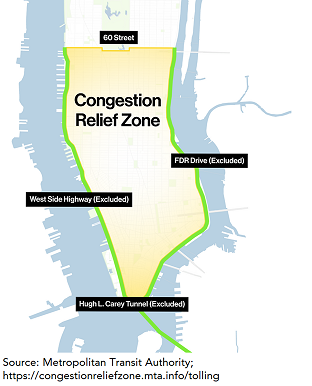In a surprise move, New York’s Democratic Governor Kathy Hochul indefinitely delayed New York City’s first-in-the-nation congestion pricing plan on Wednesday. Lawmakers created the Central Business District (CBD) Tolling Program in 2019 after a series of subway failures highlighted longstanding funding and other challenges. After five years of planning, the tax on drivers entering lower Manhattan was set to begin on June 30th.
Transit advocates, environmentalists, economists, and policy experts alike hailed congestion pricing as a solution to the city’s transportation, environmental, and budget problems. Specifically, it was expected to raise $1 billion annually for much-needed improvements to the Metropolitan Transit Authority (MTA).
So why did the governor kill it at the last second? And if congestion pricing is off the table, what’s the alternative?
Congestion pricing levies a toll on drivers entering a certain area to reduce traffic and the negative impacts of too many cars on the road. The payment is not a “user charge,” like that paid by drivers on a tolled road to access a highway or cross a bridge. Instead, congestion pricing is like a “sin tax” (such as a cigarette tax) for driving in the most over-crowded areas. It aims to change behavior (reduce driving at peak times in the CBD) and generate revenue to address related goals (fund mass transit).

In New York City, the CBD toll would have covered avenues and streets from 60th Street to the Battery, excluding the West Side Highway, FDR drive and Carey Tunnel— essentially Manhattan south of Central Park, excluding highways (pictured above).
The program was projected to reduce the number of vehicles entering the CBD each day by 14 percent, or 100,000 cars, resulting in reduced traffic, more reliable bus travel, cleaner air, and safer streets. Emissions of various pollutants were projected to fall by 5 to 8 percent, resulting in $100 million in estimated health cost savings each year, in addition to reducing traffic-related injuries and deaths.
While New York’s area-specific tolls would have been the first in the US, congestion pricing is not a new idea. Singapore has used congestion pricing since 1975. Stockholm, Rome, Milan, and London all currently use congestion pricing. In fact, London, which implemented its congestion charge in 2003, has used the $2.5 billion it raised to improve its bus system, roads and 160-year-old Tube underground.
So, what was the problem with New York’s plan? When Gov. Hochul announced the indefinite delay, she cited her desire to avoid placing financial burdens on everyday New Yorkers. True enough, the tolls were steep. A driver in a passenger vehicle would need to pay $15 to enter the CBD at peak times.
But priciness is a feature, not a bug: part of the reason for the toll is to get people to use transit instead of driving. And the congestion pricing revenue from those who still chose to drive would have been used to make crucial improvements to public transit.
The MTA would have used the $1 billion in annual congestion pricing revenue to secure $15 billion in bond financing to maintain its 110-year-old subway infrastructure and improve accessibility. Some of that would have been local funding to match $3.4 billion in federal investment in the Second Avenue Subway extension. The rest would have gone to fund a variety of projects, which may now need to be delayed and scaled back unless alternative funding is found. As a result, MTA officials warn that riders can now expect to “return to the bad old days and see service decline.”
At the time of publication, there was no plan yet to provide the MTA with alternative funding. A proposal to increase the Metropolitan Commuter Transportation Mobility Tax (a payroll tax and one of the many dedicated taxes that help fund the MTA), reportedly floated by Gov. Hochul, has already been flatly rejected by state lawmakers.
Lawmakers are now considering a plan to dedicate $1 billion in state general fund revenues to MTA for the remainder of fiscal year 2025 and find a more sustainable revenue stream next year. But it is unclear where future money would come from.
The one-time infusion of state general fund revenues would not secure the additional $15 billion in bond financing expected from congestion pricing. And neither proposal would address CBD congestion and related health, safety, and environmental issues.
Implementing the first congestion pricing plan in the US was always going to be a big political lift. The tolls create big, obvious cost burdens, while their benefits are not immediate, personal nor obvious. Sixty-three percent of New Yorkers oppose the MTA’s congestion pricing toll plan, including majorities of Democrats, Republicans, and independents. Worth noting, however: Congestion pricing was also unpopular in Stockholm before implementation, but more than 70 percent of residents supported it five years later.
There are no easy solutions for the transportation, environmental, and budget problems that densely populated urban centers face, but killing a well-researched and long-expected plan without a long-term path forward for all commuters may be the worst possible option.
